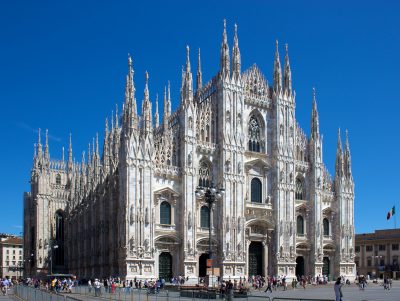Milan Cathedral Biography
Milan Cathedral is the cathedral church of Milan, Lombardy, Italy. Consecrated to the Nativity of St Mary, it is the seat of the Archbishop of Milan, now Archbishop Mario Delpini. The cathedral took almost six centuries to complete. It is the greatest church in Italy, the second greatest in Europe and the fourth greatest in the world.
Milan Cathedral Age
The erection of the Duomo officially began in 1386 by Bishop Antonio da Saluzzo and was aided by the leader of Milan Gian Galeazzo Visconti who had noble visions of the cathedral.
Milan Cathedral Facts
- Location: Via Carlo Maria Martini, 120122 Milan
- Country: Italy
- Denomination: Roman Catholic
- Tradition: Ambrosian Rite
- Website: MilanDuo.com
- Status: Cathedral, a minor basilica
- Capacity: 40,000
- Length: 158.6 meters (520 ft)
- Width: 92 meters (302 ft)
- Nave width: 16.75 meters (55.0 ft)
- Height: 108 meters (354 ft)
- Other Dimensions: Facade facing West
- Dome Height (outer): 65.6 meters (215 ft)
- Number of Spires: 135
- Spire Height: 108.5 meters (356 ft)
- Materials: Brick with Candoglia marble
Milan Cathedral History

Milan Cathedral Architecture
Milan Cathedral Roof
The roof is open to tourists, for a fee, which allows many a close-up view of some spectacular sculpture that would otherwise be unappreciated. The roof of the cathedral is renowned for the forest of openwork pinnacles and spires, set upon delicate flying buttresses.
Milan Cathedral Tickets
On information on how to purchase tickets and any queries please click here.
Facts
- Milan cathedral is a miracle in the history of architecture and construction, it took nearly six centuries to complete. The construction of the church began in 1386 and was officially completed in 1965 when the last bronze door was installed, though most parts of the building had been completed in 1813.
- Milan Cathedral is located in the very central point of the city of Milan, the layout of the city is based on the cathedral, streets are built radiating or circling it.
- Milan Cathedral is 158 meters long and 92 meters wide, its height is 108.5 meters or 356 ft, which is measured to the highest spire on the building. The church is based on a Latin cross form that covers 11700 square meters and can accommodate about 35000 people.
- The building features a variety of architectural styles, as architects from many different countries like Germany, France, Italy successively participated in the design of the church. The church was initially designed in a Gothic style, then many other architectural styles were gradually blended into the design of the church as the construction took several centuries, the included styles are Neo Classic, Baroque, and Decorative Gothic, which is the main style, the featuring of the numerous spires on the roof of the building is a representative element of the Gothic style.
- The church has five naves, a central nave and two lateral on each side, resting on 40 columns, each column is 24.50 meters (80 feet) high.
- Milan Cathedral has a large number of spires upon its roof, 135 in total, more than any other churches in the world, each spire is topped off by a sculpture of a biblical figure.
- The roof of Milan Cathedral is open to tourists for a small fee. Access to the roof is made through 6 stone stairways and two elevators. 33 stone bridges are crisscrossed on two sides of the roof, connecting the sections of the roof.
- The entrance of the cathedral is on the front side, which faces the cathedral square. There are five bronze doors at the front side of the church.
- The interior of the church features a collection of artworks, the most famous one of them being a statue of Saint Bartholomew, one of Twelve Apostles of Jesus, he was skinned alive to death for spreading his faith, the statue shows a creepy scene in which Bartholomew is holding the flayed skin on his shoulders.
- The church houses many large windows with stained glass, the three of these stained glass windows in the apse of the Cathedral are the highest in the world.
- Milan Cathedral stores a nail from the Crucifixion of Jesus Christ, there were 3 nails used to nail the hands and feet of Jesus(His feet were nailed by only one nail, as there was a nail stolen by a Gypsy), the nail stored in the Cathedral is reputedly one of these 3 nails, the holy nail is placed at a spot in the dome above the apse, marked by a small red light bulb.
- Many important events have taken place in Milan Cathedral. In 313, the famous Edict of Milan was issued from here, legalizing Christianity and making it the state religion of the Roman Empire. Leonardo da Vinci invented the first lift in Milan Cathedral.
Milan Cathedral Interior
While the exterior of the cathedral is light, decorative and encouraging, the interior seems to be almost ascetic and rather dark. Floor in the cathedral was created by Pellegrino Tibald and made in 1854 – 1940. It is made from the white Candoglia marble with Varenna black marble and Arzo red marble.
Milan Cathedral Facebook
Milan Cathedral Twitter
Milan Cathedral Instagram
https://www.instagram.com/p/Boqo2-eCt9o/?utm_source=ig_web_copy_link
About InformationCradle Editorial Staff
This Article is produced by InformationCradle Editorial Staff which is a team of expert writers and editors led by Josphat Gachie and trusted by millions of readers worldwide.
We endeavor to keep our content True, Accurate, Correct, Original and Up to Date. For complain, correction or an update, please send us an email to informationcradle@gmail.com. We promise to take corrective measures to the best of our abilities.






